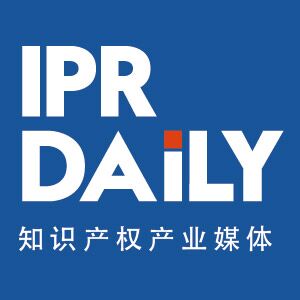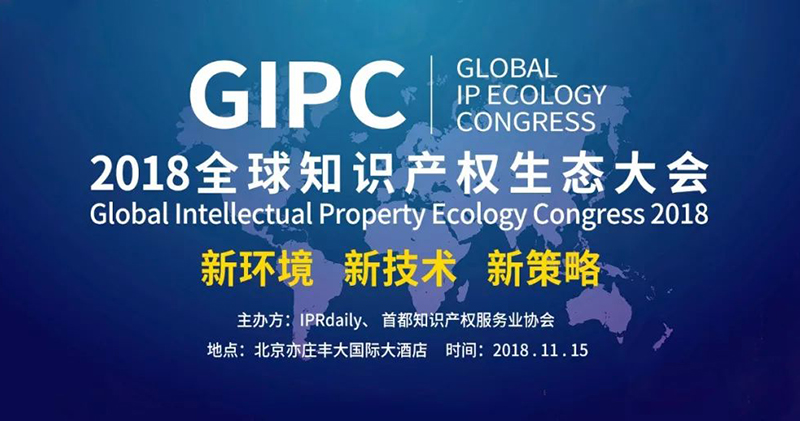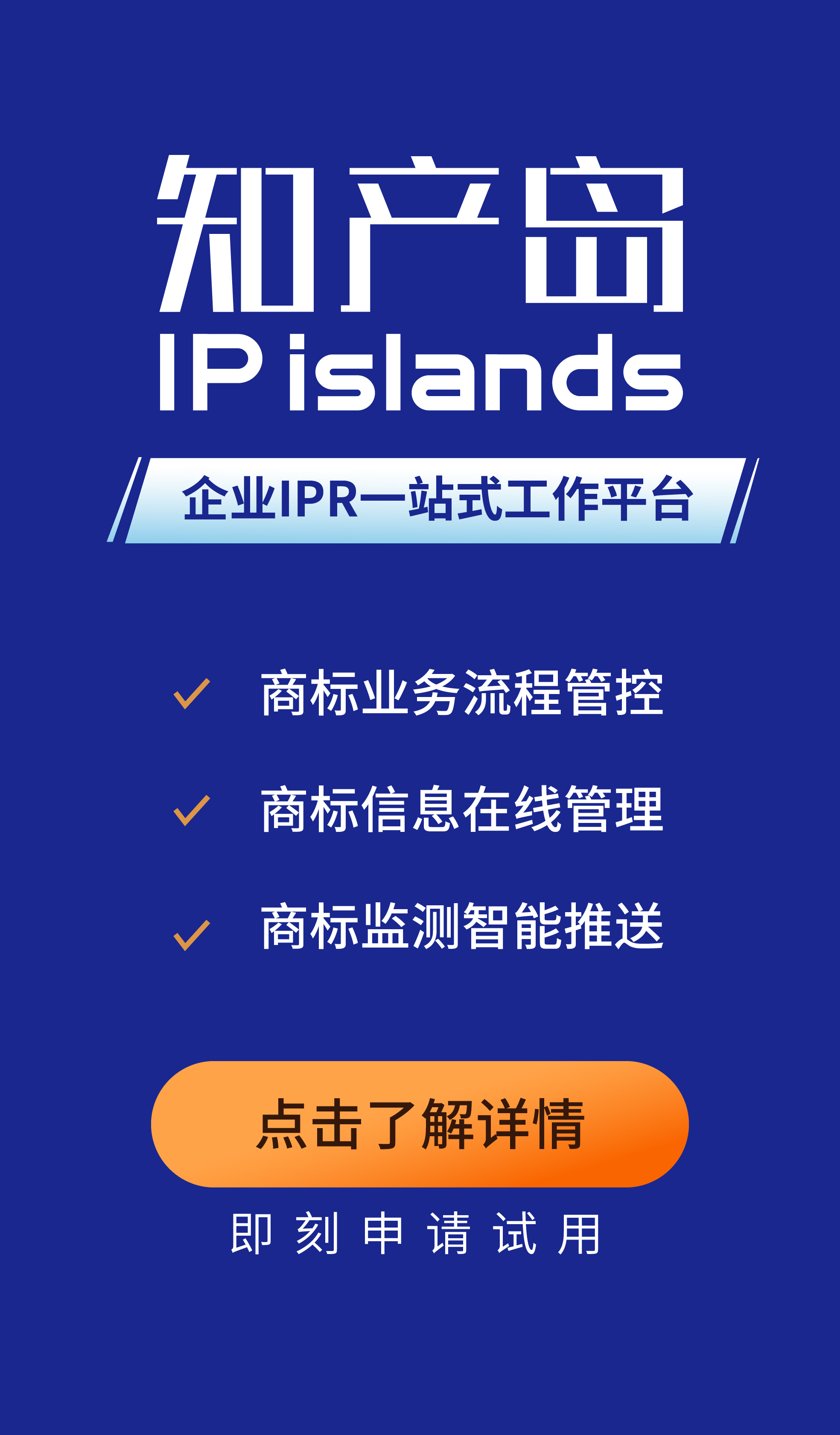
#本文由作者授权发布,未经作者许可,禁止转载,不代表IPRdaily立场#
发布:IPRdaily中文网(IPRdaily.cn)
作者:Rashad Morgan律师 及Christopher Gerardot律师
供稿:Brinks Gilson & Lione律师事务所
原标题:Natural Alternatives v. Iancu:不要破坏专利优先权链
本文案件中,由于申请人在专利链中放弃了其中一项部分连续申请案对母专利的优先权(priority claims),导致下游子专利的优先权受到影响而无法获得母专利的有效申请日(effective filing date)。文章对申请人在处理大型专利族中包含众多权利要求的优先权请求时,如何避免破坏优先权链提供了若干实际操作建议。
联邦巡回法院近期裁决的一项案件,对于那些处理大型专利族(patent families)中包含众多权利要求优先权(priority claims)问题的申请人来说,起到了提示谨慎处理的作用。
案件背景:本案Natural Alternatives v. Iancu
是一件对双方复审程序(inter partes reexamination)进行上诉的案件。本案的争议问题是:在专利链中,当申请人对之前相关专利申请的优先权进行修改,后续递交的子申请(child application)是否有资格对专利链中最早的有效申请日(the earliest effective filing date)享有优先权。本案争议专利为美国专利8,067,381(381专利),是美国专利族申请中的最后一项申请(图中8号申请),该申请请求对专利链中母专利(parent patent)的原始申请日享有优先权,既1997年8月12日递交的1号申请。
拓展:专利的申请日(filing date)与有效申请日(effective filing date)
通常,专利的保护期限是从其递交申请之日(filing date)开始计算的二十年内;但一些类型的专利申请,如分割案( division )、连续案( continuation )与部分连续案( continuation in part, CIP)等,由于其和母专利(parent patent)间的联系使它们的申请日并非实际递交日,而是可享有母案原始申请日的优先权,统称为有效申请日(effective filing date),或“优先权日(priority date)”。值得注意,有效申请日是根据各权利要求为基础(claim-by-claim basis)逐个进行评估的。
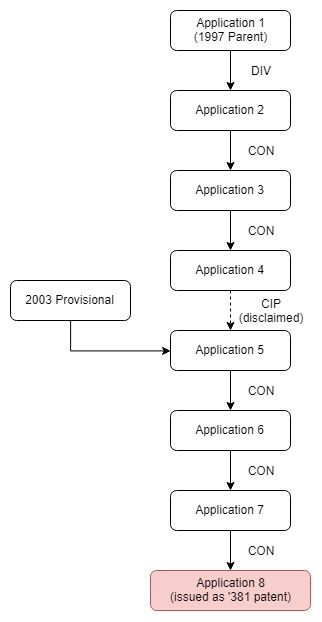
如图所示,专利链由原告Natural Alternatives International (“NAI”)递交的母案申请开始,该申请涉及一种增加运动员耐力的膳食补充剂。在1997至2011年间,NAI递交了至少7项类似主题的申请,每一项申请中均包含了优先权声明(priority statement),请求通过专利链享有对1997年母案申请的优先权。本案的381专利,由申请链中的第8号申请所核准。
专利链中的5号申请含有新的技术信息(new matter),最初以“部分连续案(continuation-in-part,CIP)”提出对1号申请的优先权请求。5号申请还分别对2003年的一项临时申请(provisional application)案提出优先权。在随后的6号申请待审期间,申请人对5号申请进行修改,移除了对专利链中前4项申请的优先权请求,然而维持了对临时申请案的优先权请求,推测是为了延长5号申请的专利期限。6号申请的优先权请求没有变动。此外,所有随后的申请中均包含了对1号申请的优先权请求,一直追溯至1997年的最初申请日。
在复审程序中,NAI辩称“381专利应享有1997年作为有效申请日”。审查员未采纳该请求,并最终基于现有技术(prior art)驳回381专利的权利要求。专利审判和上诉委员会支持驳回意见。NAI将裁决上诉至联邦巡回法院。
NAI在联邦巡回法院中的论点总结为以下四部分:
1.专利链中第6号申请的优先权请求被授予(因此为第8号申请中的专利提供以1997年作为优先权日的路径)
2.对优先权的放弃只限制于本申请(5号申请),并不延伸至专利链中的后续申请。
3.专利优先权链不是单一的增长链,而是一组多项固定链 (如,一项优先权对应每一项申请)
4.将专利优先权链视为单一的增长链,当申请人为延长专利期限对优先权进行修改时,限制了其可寻求获得保护的能力。
对于NAI的第一部分论点,联邦巡回法院认为其混淆了“请求优先权(claiming priority)”与“享有优先权(entitlement to priority)”。法院指出证明优先权的责任在申请人或专利权人,即便存在适当的优先权,也不能认为既可享有优先权。法院随后引用判例法,指出对优先权的修改可影响专利优先权链中下游的申请。“因为第5号申请缺失1号申请的优先权,第8号申请对1号申请的优先权请求(通过第5号申请)不能满足§ 120的所有要求。”
其次关于第二部分论点,NAI认为对优先权的放弃只限制于本申请(5号申请)。这一论点是基于NAI对专利审查指南(MPEP)§ 201.11的解读,其中NAI找到“对优先权的修改只适用于本申请 - 非其他申请。”法院确认MPEP不具有法律效力,并且没有在MPEP发现优先权弃权(waiver of priority)仅限制于本申请,还指出MPEP明确表示某些行为可影响下游申请(如终止声明)。
联邦巡回法院以上述相似的理由驳回了最后两个论点。
本案裁决同样为递交部分连续申请案(CIP)的从业人员提供关于有效申请日的提醒:在CIP申请中,虽然权利要求的有效申请日是根据逐个权利要求(claim-by-claim)的主题,基于母专利最早相关的递交日决定,但整个CIP申请的专利期限(所有权利要求)取决于最早的母专利优先权日期。换句话说,即使CIP中的某些权利要求有不一样的优先权日,但整个CIP专利中的所有权利要求会同时到期。因此,引入新主题后较早到期的权利要求使CIP专利整体期限缩短。CIP申请虽然可以放弃早先(母案)的优先权日以确保20年的完整专利期限,但这样的弃权声明却为申请遭遇更多现有技术的挑战埋下隐患。
启示:
1. 申请人在修改专利链中的相关申请时应格外谨慎。在极少的情况下,取消优先权具有策略性意义(注意上游申请可成为现有技术),申请人应意识到这样的弃权不仅作用于现有申请,也可能对后续申请造成专利优先权链的破坏。
而且,应通过相关申请对优先权进行仔细监控,无论是申请信息页(Application Data Sheet)还是说明书中的第一段落。专利优先权链的破坏不仅对现有申请的优先权造成影响,对下游子申请也会产生严重打击。
2. 在递交CIP申请时,也可同时递交来自相同母专利的共同待审连续申请(co-pending continuation from the immediate parent)。那么,如果申请人希望在日后放弃CIP中的优先权(如,为引入新主题的专利延长保护期限),共同待审连续申请将会为申请提供不间断的专利优先权链。
附:英文全文
Natural Alternatives v. Iancu - Priority: Don’t Break the Chain
A recent Federal Circuit decision serves as a reminder to exercise caution when dealing with large patent families with many priority claims.
Background: Natural Alternatives v. Iancu[1] involved an appeal from an inter partes reexamination. At issue in Natural Alternatives was whether a later-filed child application was entitled to priority to the earliest effective filing date when there was a modification to the priority claim by an Applicant in a previous related application. The patent at issue, U.S. Patent No. 8,067,381 (“the ‘381 patent”), was the last application in a family of U.S. applications claiming priority to the original filing date of the parent, which was filed August 12, 1997.
As shown in this diagram, the chain began when Natural Alternatives International (“NAI”) filed the parent application[2] related to a dietary supplement for increasing an athlete’s endurance. Between 1997 and 2011, NAI filed at least seven more applications with similar subject matter, each of them including a benefit priority statement (at least initially) claiming priority through the chain to the 1997 parent. The patent at issue, the ‘381 patent, issued from the eighth application in the chain.
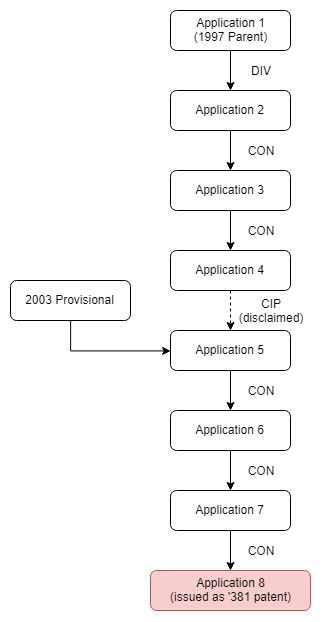
The fifth application in the chain[3], which included new matter, initially claimed priority to the filing date of the first application (via the fourth application) as a continuation-in-part (“CIP”). The fifth application separately claimed the benefit a 2003 provisional application. During the pendency of the subsequent sixth application, the fifth application was amended to remove the priority claim to the first four applications, while maintaining the priority claim to the provisional application, presumably to extend the patent term of the fifth application. The priority claim of the sixth application was not amended. In addition, all of the subsequent applications included priority claims extending all the way back to the 1997 filing date of the first application.
During the reexamination proceedings, NAI argued that the ‘381 patent should have a 1997 effective filing date. The reexamination examiner was not persuaded, and the claims of the ‘381 patent were finally rejected based on prior art (which included the patent issuing from NAI’s original 1997 filing). In the subsequent proceeding, the Patent Trial and Appeal Board issued a determination affirming the examiner’s rejections. NAI filed an appeal with the Federal Circuit.
NAI’s argument before the Federal Circuit included four parts:
1.The sixth application’s priority “vested” (thus providing a path to 1997 for the eighth patent
2.Waiver of priority is limited to the instant application and does not extend to subsequent applications in the chain.
3.The priority chain is not a single growing chain, but rather a set of multiple fixed chains (i.e., one for each application).
4.Viewing a priority chain as a single growing chain “limits an applicant’s ability to seek protection” when “amending [a] priority claim to gain [patent] term.”
The Federal Circuit found that the “vesting argument” confused claiming priority with entitlement to priority. The court recognized that the burden is on an applicant or patentee to prove priority, and that entitlement to priority is not assumed even where a proper priority claim exists. The court then cited prior Federal Circuit decisions (and consistent MPEP language) recognizing that the modification of a priority claim can affect downstream applications in a priority chain. “[B]ecause the fifth application lacked priority to the first application, the eighth application's priority claim to the first application (via the fifth application) did not satisfy all of § 120's requirements.”[4]
Next, the court rejected NAI’s argument that a cancellation of a priority claim waives priority only in the instant application. The argument was based on NAI’s reading of MPEP § 201.11[5], which NAI found that an alteration of a priority claim applies “only to the instant application – not other, ... applications.”[6] The court, while acknowledging that the MPEP “does not have the force of the law,” found nothing in the MPEP that limits waiver of priority to only the instant application and noted the MPEP has explicitly indicated when certain actions affect downstream applications (for example, terminal disclaimers).[7]
The Federal Circuit summarily rejected the final two arguments on grounds similar to those discussed above.
The opinion also serves as a reminder to practitioners about the effective filing date for CIP applications: while the effective filing date for claims in a CIP application are based on the earliest filing of the claimed subject matter (determined claim-by-claim), the patent term for the entire application (all claims) is based on the earliest claimed priority.[8] In other words, all claims in a CIP application expire at the same time even though certain claims may have different priority dates. As a result, claims reciting new matter have a truncated patent term. While it is permissible to disclaim the benefit of an earlier date to secure a full 20-year term, such a disclaimer opens up the application to a larger pool of prior art.
Takeaways:
1. Applicants should be wary of modifying priority claims in related applications. In the rare circumstance where it makes strategic sense to cancel a priority claim (with knowledge that the upstream applications could end up as prior art), an applicant should be aware that such a disclaimer may break the priority chain not just for the instant application but also for later-filed applications in the chain.
Further, claims to priority should be carefully monitored through related applications, whether in an Application Data Sheet, the first paragraph of the specification, or both. A broken priority chain not only affects the priority of the instant application, but can be fatal to downstream child applications.
2. When filing a CIP application, it may be advisable to also file a co-pending continuation stemming from the immediate parent. Then, if the applicant wishes to disclaim priority in the CIP at a later date (i.e., to extend the patent term of new matter), the co-pending continuation will provide the application with an application with an unbroken chain of priority.
[1] Natural Alternatives v. Iancu, __ F.3d __, No 2017-1962 slip Op. (Fed. Cir. Oct. 1, 2018).
[2] The 1997 patent application (Ser. No. 08/909,513) claims priority to two UK filings (9621914.2 and 9616910.7)
[3] U.S. Application No. 12/231,240, filed on August 29, 2008.
[4] Natural Alternatives, slip Op. at 10.
[5] The relevant subject matter now exists in MPEP § 11.
[6] Natural Alternatives, slip Op. at 10.
[7] Id. at 10-11.
[8] Id. at 11 (citing 35 U.S.C. § 154(a)(2)).
发布:IPRdaily中文网(IPRdaily.cn)
作者:Rashad Morgan律师 及Christopher Gerardot律师
供稿:Brinks Gilson & Lione律师事务所
编辑:IPRdaily赵珍 校对:IPRdaily纵横君
推荐阅读(点击图文,阅读全文)
IP生态新格局!「G40亚太知识产权领袖闭门峰会」震撼来袭!
“投稿”请投邮箱“iprdaily@163.com”

「关于IPRdaily」
IPRdaily成立于2014年,是全球影响力的知识产权媒体+产业服务平台,致力于连接全球知识产权人,用户汇聚了中国、美国、德国、俄罗斯、以色列、澳大利亚、新加坡、日本、韩国等15个国家和地区的高科技公司、成长型科技企业IP高管、研发人员、法务、政府机构、律所、事务所、科研院校等全球近50多万产业用户(国内25万+海外30万);同时拥有近百万条高质量的技术资源+专利资源,通过媒体构建全球知识产权资产信息第一入口。2016年获启赋资本领投和天使汇跟投的Pre-A轮融资。
(英文官网:iprdaily.com 中文官网:iprdaily.cn)
本文来自Brinks Gilson & Lione律师事务所并经IPRdaily.cn中文网编辑。转载此文章须经权利人同意,并附上出处与作者信息。文章不代表IPRdaily.cn立场,如若转载,请注明出处:“http://www.iprdaily.cn/”

 共发表文章
31245篇
共发表文章
31245篇- 我也说两句
- 还可以输入140个字
